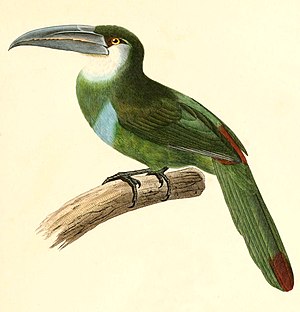Gray-billed macaws
| Gray-billed macaws | ||||||||||
|---|---|---|---|---|---|---|---|---|---|---|

Gray-billed macaws ( Aulacorhynchus coeruleicinctis ) |
||||||||||
| Systematics | ||||||||||
|
||||||||||
| Scientific name | ||||||||||
| Aulacorhynchus coeruleicinctis | ||||||||||
| d'Orbigny , 1840 |
The gray-billed macaw ( Aulacorhynchus coeruleicinctis ) is a species of bird in the toucan family. It occurs exclusively in South America. No subspecies are distinguished. The gray-beaked macaroni differs from the other Grünarassari species in its distribution area by its light-colored throat, rust-red rump and predominantly gray beak.
The IUCN classifies the gray-billed macaw as ![]() (= least concern - not endangered). Exact population figures are not known, the species is generally not considered to be very common in its large distribution area.
(= least concern - not endangered). Exact population figures are not known, the species is generally not considered to be very common in its large distribution area.
Appearance
The body length of adult gray-billed macaws is 37 to 39 centimeters. The males reach a wing length between 14.0 and 15.1 centimeters. The tail length is between 13.8 and 15.4 and the beak length between 7.6 and 9.9 centimeters. Females have similar body dimensions, the only noticeable sexual dimorphism is the length of the beak. In females this is only 6.0 to 7.5 centimeters. The weight of both sexes varies between 173 and 257 grams.
Gray-billed macaws have a predominantly green body plumage. This is a little darker on the upper side of the body, the chest and tail are paler than the rest of the plumage. A noticeable white stripe above the eye runs over the eye to the back of the head. The region under the eye is white, the feathers have blue tips. The blue is particularly intense between the eye and the ear covers. The rump is rust-red, the tail has a matt gray end band. The chin and throat are white, the feathers at the end of the throat are lined with blue. A narrow blue band runs from the sides of the chest over the chest. The belly is whitish in the middle, the flanks are green-yellow. The under tail-coverts are yellowish green.
The beak is long in relation to its size. It is colored gray. The featherless skin of the face is pale blue and brightens to white in front of the eye. The eyes are yellow to white. Some individuals, especially from the Peruvian regions of Ayacucho and Cuzco, have brown to reddish brown eyes. The legs and feet are dull greenish to light slate gray.
Distribution area and habitat
The gray-billed macaw occurs only on the eastern slopes of the Bolivian and Peruvian Andes and their foothills. The distribution area extends from the south of the Huánuco region and the Junín region to Chuquisaca and the west of the Santa Cruz department . It occurs mainly between 1600 and 2500 meters altitude, but has also been observed in Junín at 1465 meters and in the La Paz region at 3050 meters. Below 1500 meters of altitude, instead of the gray-billed macaw, you can find the Derby-Arassari in the distribution area. Only in exceptional cases are both species seen at the same height.
The habitat of the gray-billed macaw is predominantly the moist subtropical mountain forest. But it also occurs at the transitions to the temperate forest and in the semi-humid forests of the upper tropical zone. The habitat includes cloud forests with rich moss and epiphyte growth and dense undergrowth.
Way of life
The gray-billed macaws are observed individually, in pairs and in small groups. He generally hangs in the treetops, but also comes near the ground to look for fruit. Insects also belong to its food spectrum. The way of life of the gray-billed macaw has not yet been very well researched. So far there are no field observations on the reproductive behavior of this species.
supporting documents
literature
- Werner Lantermann: Toucans and Arassaris. Filander Verlag, Fürth 2002, ISBN 3-930831-46-5 .
- Lester L. Short and Jennifer FM Horne: Toucans, Barbets and Honeyguides - Ramphastidae, Capitonidae and Indicatoridae. Oxford University Press, Oxford 2001, ISBN 0-19-854666-1 .
Single receipts
- ↑ Aulacorhynchus coeruleicinctis in the IUCN Red List of Threatened Species 2011.1. Listed by: BirdLife International, 2009. Retrieved July 22, 2011.
- ↑ Lantermann, p. 118
- ↑ a b c Short et al., P. 340.
- ↑ Short et al., P. 339
- ↑ Lantermann, p. 119
- ↑ Short et al., P. 341
Web links
- BirdLife factsheet on the gray-billed macaw
- Videos, photos and sound recordings for Blue-banded Toucanet (Aulacorhynchus coeruleicinctis) in the Internet Bird Collection
- Gray-billed macaws ( Aulacorhynchus coeruleicinctis ) at Avibase; accessed on November 8, 2018.